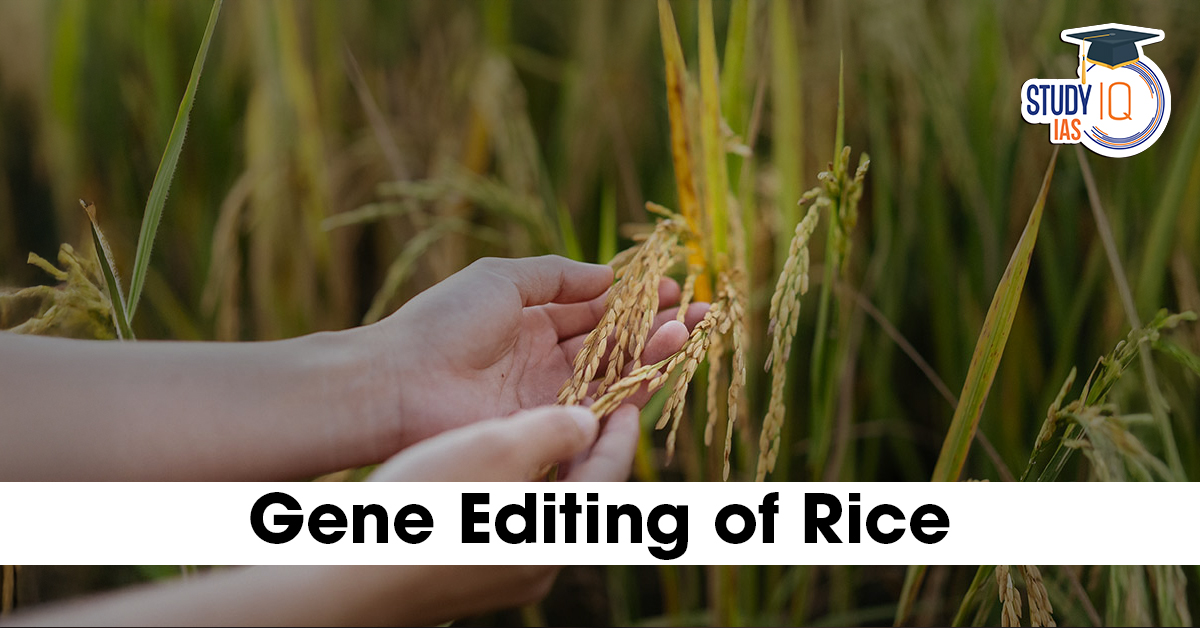Table of Contents
Context: Two varieties of rice – ‘DRR Dhan 100 (Kamala)’ and ‘Pusa DST Rice 1‘, developed by ICAR and its institutes – are the world’s first genome-edited varieties, and promise to be a game-changer in sustainable agriculture.
What Makes Gene Editing of Rice Varieties a Game-Changer
- Higher Yields: They offer 20%-30% more yield compared to traditional varieties.
- Potential to produce 5 million tonnes of additional paddy when cultivated on 5 million hectares.
- Water Efficiency: These varieties require significantly less irrigation water.
- Can help save 7,500 million cubic metres of water, addressing the growing water stress in agriculture.
- Traditional rice requires ~2,500 litres of water per kg, making this a major breakthrough.
- Climate Resilience: The new varieties are drought-tolerant, helping farmers deal with climate change-induced water scarcity.
- They are better suited for a future with less water and more extreme weather.
- Reduced Methane Emissions: Methane, a potent greenhouse gas, is commonly emitted from paddy fields.
- These new varieties can reduce methane emissions by up to 20%, contributing to climate mitigation.
- No Foreign DNA – Less Regulatory Burden: The varieties are genome-edited using SDN1 and SDN2 techniques, not genetically modified (no foreign DNA inserted).
- This makes them equivalent to natural mutations and exempt from stringent GM regulations.
- Cleared by India’s Review Committee on Genetic Manipulation (RCGM).
- Targeted Adaptation: Derived from widely cultivated rice strains like Samba Mahsuri and MTU1010, they retain local adaptability and taste.
- Suitable for states like Tamil Nadu, Andhra Pradesh, Odisha, Chhattisgarh, Maharashtra, Bihar, and Eastern Uttar Pradesh.
- Seed Sovereignty & Quick Adoption: Genome editing allows the preservation of native strengths of existing varieties while improving resilience.
- Commercial seed availability is expected within two years, fast-tracking adoption.
Implications for Sustainable Agriculture
- Helps India meet food security needs sustainably for a population of over 800 million rice consumers.
- Aligns with SDG goals: Zero Hunger (SDG 2), Climate Action (SDG 13), and Sustainable Water Management (SDG 6).
- Reduces pressure on over-exploited groundwater and irrigation resources.
- Sets a model for low-input, high-efficiency agriculture using modern science.
Challenges & Opposition
- Coalition for a GM-Free India opposes these varieties, citing health, environmental, and seed sovereignty concerns.
- The debate on regulation and public trust in new biotechnology is ongoing, despite scientific reassurances.
Way Forward
- Effective Communication to farmers and the public about genome editing vs GM.
- Accelerated Seed Multiplication to ensure timely farmer access.
- Agro-extension support to help farmers adopt water-saving practices alongside new varieties.
- Monitoring of environmental outcomes post-deployment to reassure stakeholders.


 Advanced Air Defence Radars: Types, Comp...
Advanced Air Defence Radars: Types, Comp...
 Ion Chromatography, Working and Applicat...
Ion Chromatography, Working and Applicat...
 Broadly Neutralising Antibodies (bNAbs):...
Broadly Neutralising Antibodies (bNAbs):...

























